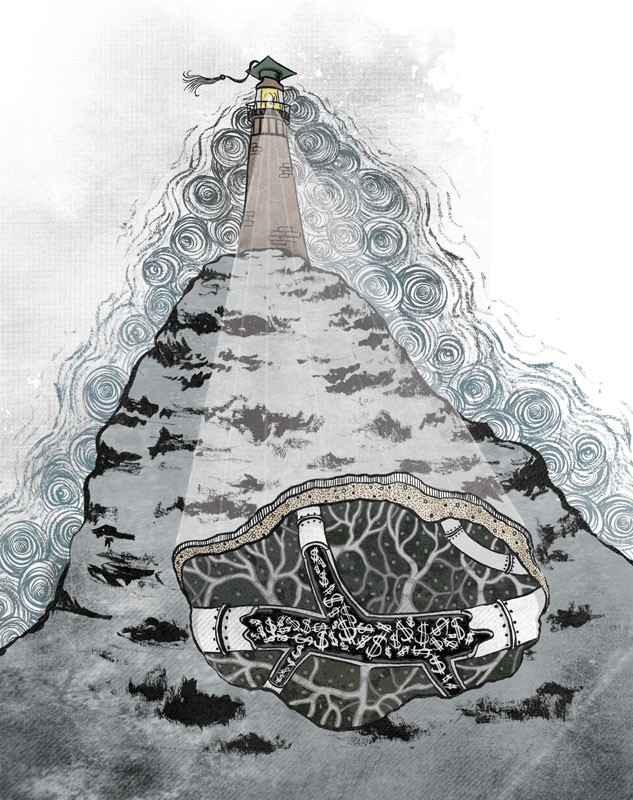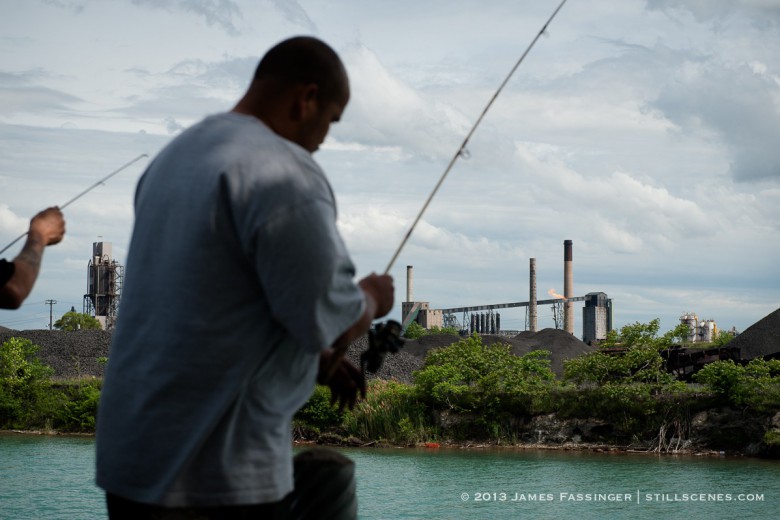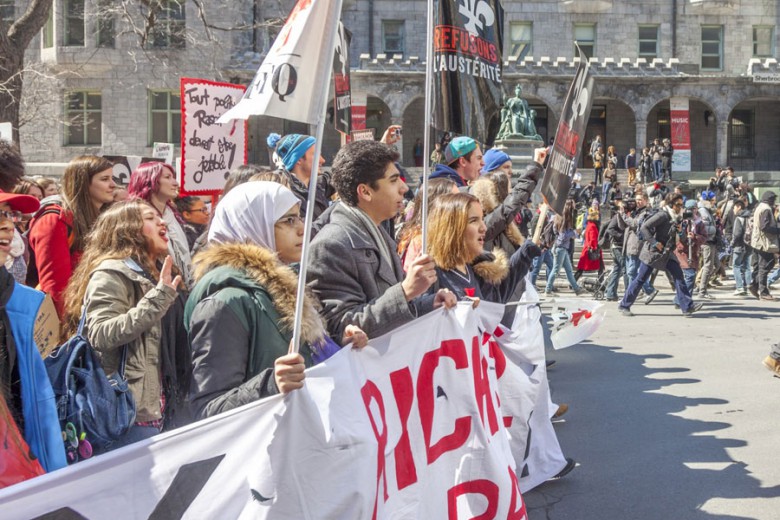
Since last spring, a new weapon has been added to the arsenal against climate change and fossil fuel consumption in Canada. It’s a familiar word being used in a new context: divestment. Popularized in the fight against South African apartheid, and gaining strength in its more recent application against Israel, divestment is something proponents hope will trigger the shift needed to build a national youth movement to “keep the oil in the soil.”
Early signs suggest the divestment campaign has traction. According to a study from the Smith School of Enterprise and the Environment, based at Oxford University, it is spreading faster than the anti-apartheid divestment campaign against South Africa did, with six U.S. universities and colleges already pledging to divest. According to Canadian organizers, there are also over 300 active campaigns on campuses, in public institutions, and among pension funds worldwide. Of those, over a dozen are active on Canadian campuses, and there is a strong feeling among organizers that Montreal’s McGill University could be the first to divest by the end of the 2014 academic year.
The simplicity of the campaign seems attractive: universities and public institutions are encouraged to withdraw funding from fossil fuel investments, exerting financial pressure on oil and gas companies.
But as divestment organizers will tell you, scratch the surface and the easy math disappears to reveal a complicated if not contradictory effort to stigmatize the fossil fuel industry into scaling back its operations. Indeed, for some, presenting such a complex issue as outwardly simple could be the project’s greatest weakness. If the deeper links between fossil fuels, capitalist production, and colonialism are ignored in order to popularize the campaign, critics fear that divestment will be more of a shell game than a solution.
Divestment comes north
Started in the U.S. by environmental crusader Bill McKibben, co-founder of 350.org, the divestment campaign was released to much fanfare when McKibben published his essay “Global Warming’s Terrifying New Math” in Rolling Stone in 2012. In it, he proposed a far-reaching divestment campaign among universities and pension funds, starting in the U.S. but spreading worldwide.
The cause was swiftly taken up in Canada. Under the banner of Fossil Free Canada, it is being spearheaded by the Canadian Youth Climate Coalition whose hope is to have public institutions – beginning with universities – divest from fossil fuel development.
The focus on universities is a tactical choice, says Lily Schwarzbaum, the field organizer for the Fossil Free Canada campaign and co-founder of the group Divest McGill. “The university holds a very specific and powerful social legitimacy in society,” she explains. She describes universities as “moral beacons” such that “what a number of universities say all together has enormous impact on the social licence of the industry.” Campuses of course also provide a young, active, and often more socially progressive base that can help build momentum for a campaign before it moves to other sectors.
Irrespective of the morality of universities as institutions, however, they may not have the financial clout to slow the fossil fuel industry in the first place. The recent Smith School report Stranded Assets and the Fossil Fuel Divestment Campaign paints a clear picture: in Canada, the U.S., the U.K., and Australia, universities hold endowments of just under $450 billion, only a fraction of which is directly linked to the oil and gas industry. The market valuation of publicly held fossil fuel companies, including oil, gas, and coal, is $4 trillion. And that doesn’t include some of the largest oil companies, such as the state-owned Saudi Aramco in Saudi Arabia or PDVSA in Venezuela.
Both Schwarzbaum and Bronwen Tucker, the main divestment organizer at McGill, recognize that the financial impact isn’t the ultimate goal. “I think that the role of money in this campaign is more about symbolism than financial impact,” says Schwarzbaum. Universities would be “putting their money where their mouth is. It shows a seriousness and commitment that otherwise could be ignored.”
But on the campaign’s central online hub, gofossilfree.ca, the language centres on withholding money from the fossil fuel industry. And it’s in this dissonance that some see the campaign’s major flaw.
Amanda Lickers is an Indigenous activist from the Turtle Clan of the Onondowa’ga Nation who has been active in the campaign to stop Enbridge from reversing its Line 9B pipeline from Hamilton to Montreal. The campaign included the Swamp Line 9 actions last year in which Enbridge’s Westover, ON facilities were occupied. The reversal of the pipeline would allow it to complete a west-to-east transportation route in order to send tarsands bitumen to the East Coast. While Lickers sees the importance of a wide range of tactics, she also says that large, well-funded campaigns that focus on reforms risk over-shadowing more direct tactics aimed at halting climate change.
Schwarzbaum and Tucker also believe that divestment isn’t the sole tool necessary for stopping catastrophic climate change. “There’s a saying I like: ‘Divestment is the tool. Climate justice is the goal,’ ” says Schwarzbaum. But others like Lickers worry the campaign will serve to marginalize other actions.
Framing the debate
An important missing link, says Lickers, is the language around the campaign. From the logo of a raised fist holding a wind turbine, to the focus on market solutions, to the displacement of Indigenous people’s concerns, she wonders whether the approach goes far enough in addressing the root causes of what she terms the ongoing genocide of Indigenous peoples.
Can a campaign focusing on market solutions address a problem that goes beyond fossil fuels and reaches to the heart of the system? Pulling money out of one stock portfolio can mean a shift to another destructive industry like mining or to industries indirectly tied to fossil fuel such as aerospace and auto manufacturing. Perhaps most insidious of all is the belief in a benign “green economy” that maintains the fundamental structures of capitalist production and colonial control.
An economics student, Tucker agrees there are limitations to advancing market-based solutions for market-based problems. But she thinks divestment can open up an avenue for more in-depth conversations about economics. “I’m definitely interested in de-growth economics,” she says. She believes it’s necessary first to raise consciousness through the campaign.
Meanwhile, Indigenous populations like the Athabasca Chipewyan First Nation downstream from the tarsands or the Aamjiwnaang First Nation in southern Ontario’s Chemical Valley are already living at ground zero for the fossil fuel industry’s impact, says Lickers.
Lickers compares the Canadian divestment campaign to the Boycott, Divestment, and Sanctions (BDS) campaign against Israeli apartheid. In that case, the BDS campaign arose in response to a call from the Palestinian people themselves. “That narrative doesn’t exist with the fossil fuel campaign. There’s no discussion about solidarity with Indigenous struggles in Turtle Island, and I think this is a huge framing piece,” says Lickers. “If the campaign was Divest from Canadian Genocide, then it would be different because of the type of awareness raising that it would be doing.” As it is, she worries the campaign can be co-opted by “green capitalists” who hope to protect their current lifestyle instead of restructuring society in order to protect all communities.
While the divestment campaign doesn’t make Canadian colonialism a central issue, organizers say that exposing the links between capitalism, colonialism, and climate change is important. Both Schwarzbaum and Tucker have been involved with the climate justice movement outside of the university and have encouraged those involved in the divestment campaign to join in other actions such as the protests this past October at the National Energy Board’s hearings on the reversal of Line 9B.
Capitalizing on campuses
If there’s something on which Lickers, Schwarzbaum, and Tucker fundamentally agree, it’s the power of mobilizing campuses. “I feel like there hasn’t been a North American student movement in my generation,” says the 23-year-old Schwarzbaum. “The Quebec student strike and Occupy were notable, but I see [climate change] as being so unique to my generation. I’d feel really proud if this ends up being the big issue. I’ve been thinking a lot about attitudes towards millennials – you’re lazy, you’re apathetic, and so on – and yet this is happening, and it’s exciting. It has momentum.”
“There’s a lot of potential [on campuses] in terms of organizing and in terms of igniting resistance, as we saw with the Quebec student strike,” agrees Lickers. She nonetheless remains skeptical about how well university-based campaigns will build links with marginalized communities and stresses the vital role Indigenous academics can play in framing the debate.
As the divestment campaign moves forward on campuses across the country, the challenge will be to ensure that Indigenous voices on and off campuses are able to speak up alongside the divestment campaign, helping guide discussion.
Schwarzbaum feels they’re up to the challenge. “I think there are different levels of pressure that need to apply to the fossil fuel industry. Voices of grassroots activists need to exist parallel to big institutions and vice versa. I wouldn’t care what universities are saying if it wasn’t backed up by what grassroots activists are saying.”






